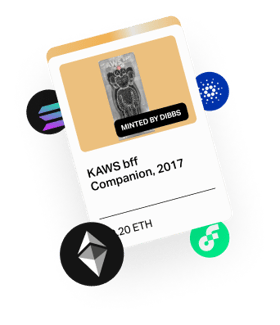A Business' Guide to Minting Redeemable NFTs

Discover how to mint redeemable NFTs starting from defining the type of NFTs to marketing your campaign.
Redeemable NFTs are digital collectibles that can be exchanged for real-world assets, experiences or benefits. They have garnered significant interest from customers as they provide tangible value and create a sense of exclusivity due to their uniqueness.
For businesses, these benefits translate into golden opportunities to enhance the customer experience, create innovative business models, and unlock new revenue streams.
But how exactly can businesses mint redeemable NFTs linked to their items?
In this article, we’ll explore the five steps businesses should follow to mint redeemable NFTs.
Subscribe to get our best content in your inbox
By clicking “Submit” you agree to Dibbs
Privacy Policy and
consent to Dibbs using your contact data for newsletter purposes.

Step 1: Define the Type of NFT
Before deciding on the types of NFTs, let’s look at some types of redeemable NFTs brands can leverage to enhance the customer experience:
- Experience or Event NFTs: Event or experience NFTs serve as a passport to unique events or experiences. A notable example is Burger King's 'Keep It Real' meals campaign, where users could scan a QR Code on meal boxes to obtain digital collectibles that could unlock a celebrity phone call.
- Phygital NFTs: Phygital NFTs are digital tokens that can be redeemed for a real-world product. Nike's RTFKT collection and Damien Hirst's "The Empresses" collection both exemplify the concept of phygital NFTs.
- Multi-redeemable NFTs: Multi-redeemable NFTs are digital tokens that allow holders to claim associated benefits multiple times, either for a set duration or indefinitely.
- Partially redeemable NFT: The NFT domain experienced a notable change following OpenSea's recent declaration about fractional NFTs.
The type of NFTs brands can use depends on the needs of their target customers. Event or experience NFTs cater to customers who value unique experiences over benefits like discounts.
Multi-redeemable NFTs, on the other hand, are the best choice for customers who prefer discounts. For example, eCommerce platforms can offer regular shoppers NFTs that change appearance once they’ve renewed a discount they earned after reaching a certain milestone.
If the brand itself is known for the products it offers, like Nike or Adidas, it should consider offering phygital NFTs to amplify customer experience.
You can decide what type of NFT your brand wants to create based on what your audience might be most interested in.
Step 2: Choose a Blockchain
The choice of a blockchain significantly influences the success of a redeemable NFT campaign. If a business chooses a blockchain with limited scalability, it may get congested during times of high demand, leading to delayed transactions and high gas fees.
On the other hand, trading scalability for security can make a campaign susceptible to hacks. Both situations — high gas fees and hacks — result in poor customer experience and erodes the trust customers have placed in the business.
If a brand and its customers are eco-conscious, another factor — the blockchain’s environmental impact — comes into play. For example, Starbucks chose Polygon as it uses less energy than proof-of-work blockchains.
Step 3: Design User Experience
The average customer isn’t familiar with concepts like wallets, private keys, gas fees, and minting. To ensure that this knowledge gap doesn’t deter customers from obtaining a redeemable NFT, brands need to create a user-friendly claim and redemption process.
Burger King’s ‘Keep It Real’ campaign executed this aspect very well. Instead of sending customers to an NFT marketplace or asking them to set up a wallet, they simply asked customers to scan a QR code to claim their NFTs. Even Reddit allows its users to claim NFT avatars based on Polygon without the need for users to create a wallet.
To achieve this level of simplification, brands can set up custodial or non-custodial wallets on the user’s behalf, integrate NFT capabilities directly into their platform, or collaborate with third-party services to simplify NFT issuance, management, and trading.
The next challenge lies with the redemption experience. Brands must clearly outline the steps to redeem NFTs. They should also provide real-time notifications on the redemption status so customers are kept well-informed and don’t abandon the process midway.
In addition to this, brands should partner with a tokenization service like Dibbs so they don’t have to go through the hassle of tokenizing assets and shipping items to customers.
Step 4: Link NFT to Redeemable Item
Once businesses have chosen a blockchain, defined the type of NFT and created digital collectibles, all they’ve got to do is link the NFT to its real-world counterpart.
This link will act as proof of ownership and ensure that only the rightful person can redeem the NFT. For digital items like exclusive content, memberships, etc., brands can token-gate access only to the rightful NFT holder by directly embedding it in the NFT's metadata.
But if the brand’s NFT is a digital twin or a physical item, they can be linked through methods like serial numbers, QR codes, or NFC (Near Field Communication) chips.
Customers can verify the linked QR code, access token, or NFC chip with their smartphones to get access to the NFT and redeem the product.
Step 5: Launch the NFT Campaign
Brands can leverage several effective strategies to market their NFT campaign. They can post teasers on social media, collaborate with other brands or influencers, and generate buzz by offering early access or sneak peeks to customers.
For example, Adidas partnered with CryptoPunks and BAYC collection, and NFT artist gmoney to launch the ‘Into The Metaverse’ campaign. This enabled Adidas to engage with a broader audience, amplifying the campaign's reach and impact.
Mint Redeemable NFTs with Dibbs
While redeemable NFTs hold numerous benefits for both brands and their customers, implementing them can be challenging due to the complexities associated with tokenization and delivery process.
Dibbs, a Tokenization-as-a-Service (TaaS) platform, eliminates these complexities. We take care of everything from tokenization assets to storing them securely and delivering them to your customers so you can deliver the best customer experience every time. To learn more about how Dibbs can help your business create digital tokens, schedule a demo.

Jonathan Barbone
Jonathan Barbone is the Senior Director of Partnerships at Dibbs. Jonathan was an avid Magic: The Gathering card collector as a child.

